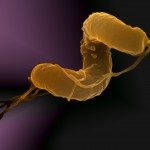Lien vers Pubmed [PMID] – 31487328
PLoS Pathog. 2019 Sep;15(9):e1007972
The biogenesis of bacterial cell-envelope polysaccharides requires the translocation, across the plasma membrane, of sugar sub-units that are produced inside the cytoplasm. To this end, the hydrophilic sugars are anchored to a lipid phosphate carrier (undecaprenyl phosphate (C55-P)), yielding membrane intermediates which are translocated to the outer face of the membrane. Finally, the glycan moiety is transferred to a nascent acceptor polymer, releasing the carrier in the “inactive” undecaprenyl pyrophosphate (C55-PP) form. Thus, C55-P is generated through the dephosphorylation of C55-PP, itself arising from either de novo synthesis or recycling. Two types of integral membrane C55-PP phosphatases were described: BacA enzymes and a sub-group of PAP2 enzymes (type 2 phosphatidic acid phosphatases). The human pathogen Helicobacter pylori does not contain BacA homologue but has four membrane PAP2 proteins: LpxE, LpxF, HP0350 and HP0851. Here, we report the physiological role of HP0851, renamed HupA, via multiple and complementary approaches ranging from a detailed biochemical characterization to the assessment of its effect on cell envelope metabolism and microbe-host interactions. HupA displays a dual function as being the main C55-PP pyrophosphatase (UppP) and phosphatidylglycerol phosphate phosphatase (PGPase). Although not essential in vitro, HupA was essential in vivo for stomach colonization. In vitro, the remaining UppP activity was carried out by LpxE in addition to its lipid A 1-phosphate phosphatase activity. Both HupA and LpxE have crucial roles in the biosynthesis of several cell wall polysaccharides and thus constitute potential targets for new therapeutic strategies.

